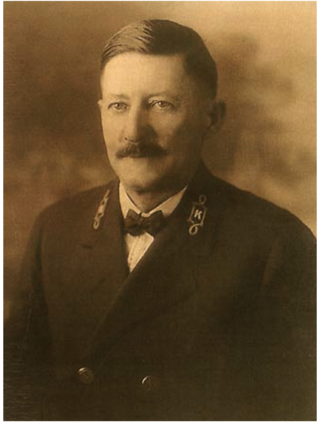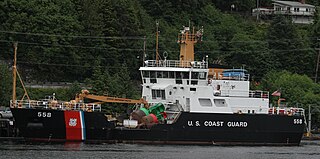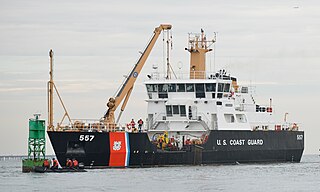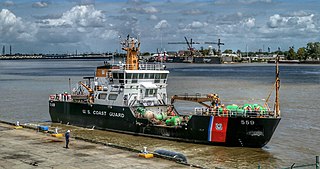
The Keeper class of coastal buoy tenders consists of fourteen ships built for and operated by the United States Coast Guard. The ships were launched between 1995 and 1999 and all remain in active service. Their primary mission is to maintain thousands of aids to navigation, both buoys and land-based. Their secondary missions include marine environmental protection, search and rescue, law enforcement, and light ice-breaking.

USCGC Spar (WLB-206) is a United States Coast Guard Juniper-class seagoing buoy tender home-ported in Duluth, Minnesota. The ship maintains aids to navigation in the Twin Ports and Great Lakes.

USCGC Maple (WLB-207) is a Juniper-class seagoing buoy tender operated by the United States Coast Guard. She was based at Sitka, Alaska for 16 years and is currently homeported at Atlantic Beach, North Carolina. Her primary mission is maintaining aids to navigation, but she also supports search and rescue, law enforcement, oil spill response, and other Coast Guard missions.

Frank Albert Drew (1864–1931) was a lighthouse keeper. He was Assistant Keeper Pilot Island Light from 1899 to 1903, First Assistant Keeper, Green Island Light-Station from 1903 to 1909, and Keeper of Green Island Light-Station from 1904 to 1929.

USCGC Juniper (WLB-201) is the lead ship of the U.S. Coast Guard's current class of seagoing buoy tenders. She is outfitted with some of the most advanced technological and navigational capabilities currently available.

USCGC Fir (WLB-213) is a Juniper-class cutter of the United States Coast Guard. USCGC Fir is under the Operational Control (OPCON) of the Commander of the Thirteenth Coast Guard District and is homeported in Astoria, Oregon. Fir's primary area of responsibility is the coastal waters, river bars and high seas of the Washingtonian and Oregonian coasts. USCGC Fir conducts heavy lift aids to navigation operations, law enforcement and other missions as directed.

USCGC Elm (WLB-204) is a U.S. Coast Guard Juniper-class seagoing buoy tender home-ported in Astoria, Oregon. She is responsible for maintaining aids to navigation on the coasts of Oregon and Washington, including the Columbia River.

USCGC Henry Blake (WLM-563) is a United States Coast Guard Keeper-class cutter based at Naval Station Everett in Everett, WA. Henry Blake's primary mission is the maintenance of 80 lighted, 39 unlighted, and 65 shore-based aids to navigation in the Puget Sound area and along the coast of Washington. Secondary missions include marine environmental protection, search and rescue, and homeland security. Henry Blake is assigned to the Thirteenth Coast Guard District.

USCGS Katherine Walker (WLM-552) is a Keeper-class coastal buoy tender of the United States Coast Guard. Launched in 1996, she has spent her entire career homeported at Bayonne, New Jersey. Her primary mission is to maintain 335 aids to navigation in New York Harbor, Long Island Sound, and surrounding waters. She is assigned to the First Coast Guard District.

USCGC Ida Lewis (WLM-551) is the lead ship of the United States Coast Guard Keeper-class of Coastal Buoy Tenders. Launched in 1995, she has spent her entire career maintaining navigational aids near her homeport of Newport, Rhode Island. Ida Lewis is assigned to the First Coast Guard District.

USCGC Anthony Petit (WLM-558) is a Keeper-class coastal buoy tender of the United States Coast Guard. Launched in 1999, she has served her entire career maintaining navigational aids in Southeast Alaska. She is assigned to the Seventeenth Coast Guard District.

USCGC Marcus Hanna (WLM-554) is a Keeper-class coastal buoy tender of the United States Coast Guard. Launched in 1997, she is home-ported in South Portland, Maine. Her primary mission is maintaining 376 aids to navigation from Boston to St. John's Bay, Maine. Secondary missions include marine environmental protection, light icebreaking, search and rescue, and security. She is assigned to the First Coast Guard District.

USCGC Abbie Burgess (WLM-553) is a Keeper-class coastal buoy tender of the United States Coast Guard. Launched in 1997, she is home-ported in Rockland, Maine. Her primary mission is maintaining 366 aids to navigation from Boothbay Harbor, Maine to the Canadian border. Secondary missions include marine environmental protection, light icebreaking, search and rescue, and security. She is assigned to the First Coast Guard District.

USCGC Frank Drew (WLM-557) is a Keeper-class coastal buoy tender of the United States Coast Guard. Launched in 1998, she is home-ported in Portsmouth, Virginia. Her primary mission is maintaining over 300 aids to navigation in lower Chesapeake Bay, the rivers that flow into it, and a potion of the North Carolina Coast. Secondary missions include marine environmental protection, light icebreaking, search and rescue, and security. She is assigned to the Fifth Coast Guard District.

USCGC George Cobb (WLM-564) is a Keeper-class coastal buoy tender of the United States Coast Guard. Launched in 1999, she is home-ported in San Pedro, California. Her primary mission is maintaining over 178 floating aids to navigation on the California coast from San Francisco to San Diego. Secondary missions include marine environmental protection, search and rescue, and security. She is assigned to the Eleventh Coast Guard District.

USCGC William Tate (WLM-560) is a Keeper-class coastal buoy tender of the United States Coast Guard. Launched in 1999, she is home-ported in Philadelphia, Pennsylvania. Her primary mission is maintaining over 260 aids to navigation on the Delaware River, in Delaware Bay and in nearby waterways. Secondary missions include marine environmental protection, search and rescue, and security. She is assigned to the Fifth Coast Guard District.

USCGC Maria Bray (WLM-562) is a Keeper-class coastal buoy tender of the United States Coast Guard. Launched in 1999, she is home-ported in Atlantic Beach, Florida. Her primary mission is maintaining over 300 aids to navigation from Georgetown, South Carolina to Fort Pierce, Florida. Secondary missions include marine environmental protection, search and rescue, and security. She is assigned to Sector Jacksonville of the Seventh Coast Guard District.

USCGC Harry Claiborne (WLM-561) is a Keeper-class coastal buoy tender of the United States Coast Guard. Launched in 1999, she is home-ported in Galveston, Texas. Her primary mission is maintaining aids to navigation between the Mexican boarder and the mouth of the Mississippi River. Secondary missions include marine environmental protection, search and rescue, and security. She is assigned to the Eighth Coast Guard District.

USCGC Barbara Mabrity (WLM-559) is a Keeper-class coastal buoy tender of the United States Coast Guard. Launched in 1999, she is home-ported in Mobile, Alabama. Her primary mission is maintaining aids to navigation from western Florida to the Mississippi River. Secondary missions include marine environmental protection, search and rescue, and security. She is assigned to the Eighth Coast Guard District.

USCGC Red Birch (WLM-687) is a Red-class coastal buoy tender that was designed, built, owned, and operated by the United States Coast Guard. She was launched in 1965 and initially homeported at San Francisco. Her primary mission was maintaining 160 aids to navigation in San Francisco, San Pablo, and Suisun Bays, and in the San Joaquin River. Red Birch also brought supplies to the Farallon Island lighthouse. In 1976 the Coast Guard reassigned her to Baltimore, Maryland, where she spent the rest of her career. There she maintained over 300 aids to navigation including several lighthouses. Her secondary missions included search and rescue, light icebreaking, law enforcement, and marine environmental protection.

























